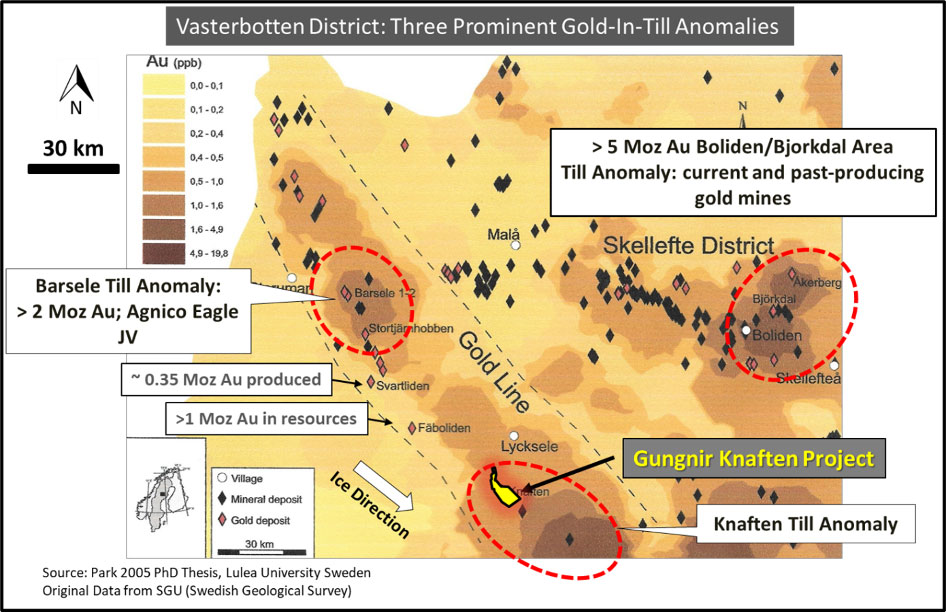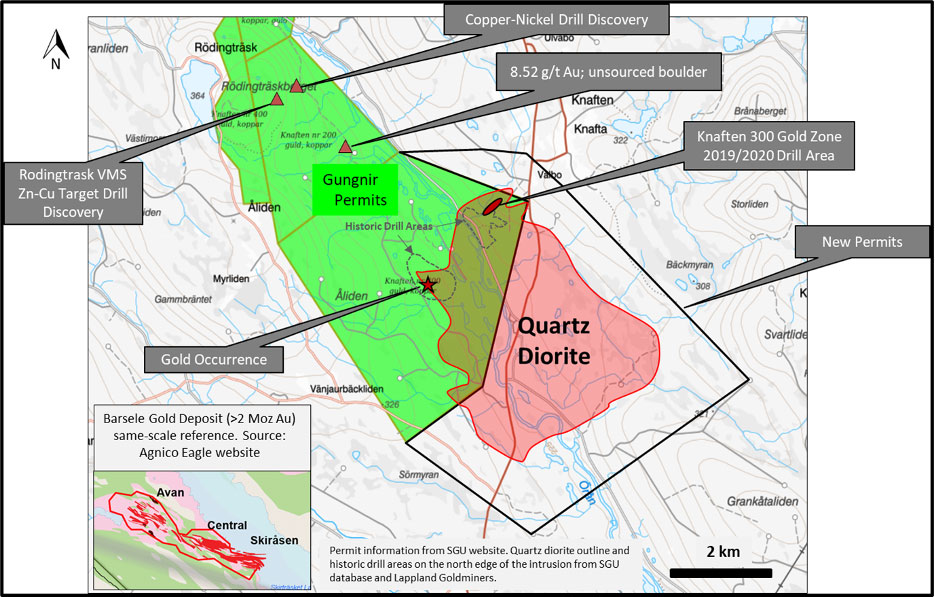
Welcome To the Gungnir Resources Hub on AGORACOM
Focused on Discovery in Sweden DELIVERING SHAREHOLDER VALUE WITH EXPLORATION SUCCESS

Gungnir Resources Inc. is a Canadian-based TSX-V listed mineral exploration company (GUG: TSX-V) focused on gold and base metal exploration in Sweden. The Company holds exploration permits in Sweden’s mineral-rich Vasterbotten District which hosts 12 million ounces of gold delineated in existing and mined resources plus several past-producing and producing base metal mines. Gungnir additionally holds a $5,000,000 royalty stream and received the first annual payment of $1,000,000 on May 2, 2017. The next annual payment of $1,000,000 is due on April 30, 2018.
The Company’s key focus is its Knaften project in Sweden. The property is located at the south end of the “Gold Line” which hosts a number of gold deposits including Faboliden and Svartliden (Dragon Mining), and Barsele (Agnico Eagle and Barsele Minerals). The Company also holds permits covering two nickel deposits, Lappvattnet and Rormyrberget, which collectively host 70 million pounds of nickel in historical resources, and newly staked Norrbotten gold and base metal permits in the Norrbotten District further to the north.
Gungnir Resources was the result of re-branding in 2014 through various business transactions, and now is fully focused on exploration and discovery in Sweden. Gungnir has a sound management team and board with extensive experience and proven success in mineral exploration, mining and financing.
Why Sweden? Sweden is the leading mining nation in Europe and continues to receive high institute rankings as one of the top countries in the world for exploration and mining. Mining is a traditional industry in Sweden which extends back over a thousand years. Sweden covers part of the Fennoscandian shield, a mineral rich but highly underexplored region. Sweden continues to offer excellent ore discovery potential, in particular under glacial till (sand and gravel) which covers large areas of Sweden.
Mr. Jari Paakki, P.Geo., is a Qualified Person as defined by National Instrument 43-101 - Standards of Disclosure for Mineral Projects. Mr. Paakki prepared the technical information contained on this website and has approved its disclosure.
The Knaften project...................
The Knaften project covers 37.2 sq. km within a highly under-explored and prospective area ("Gold Line”) in the Vasterbotten District of northern Sweden. The region hosts more than 12 million ounces of gold delineated in existing and mined resources plus several producing and past-producing VMS base metal mines.

The property covers Au in boulders and outcrop, as well as drill-indicated Au mineralization (Knaften 300 Gold Zone; 50+ drill holes), along a developing 10+ km long geochemical-magnetics trend along the western contact of a granitic intrusion that cores the Knaften greenstone belt. The main source of the large Au-in-till anomaly (one of the largest in Sweden) to the southeast is believed to be located within the Knaften belt. Other gold-in-till anomalies in the Vasterbotten District cover either current and past-producing gold mines or known gold resources. The Knaften belt also offers potential for volcanogenic massive sulphide (VMS) base metals and newly identified Ni-Cu sulphides.

The Knaften property is a prospective intrusion-related gold target with gold mineralization occurring both in the intrusive and adjacent sedimentary and volcanic rocks as disseminated replacement style mineralization (Gungnir’s 2014 discovery area, up to 8.52 g/t Au), stock works and veins. Intrusion-related gold systems are an economically important class of gold deposits which are attractive targets as their size can be very large with open pit grades to high-grade gold. With this model and the fact that the property covers up-ice of a very large glacial gold in till anomaly, which has yet to be fully sourced, makes Knaften that much more of an attractive target.

Prior work consisted of drilling over several phases from 1995 to 2008 by Swedish exploration groups including North Atlantic Nickel (NAN) and most recently Lappland Goldminers. Drilling was concentrated mainly in two areas approximately 3 km southeast of Gungnir’s new gold prospect area which the Company discovered in 2014. As described by Lappland Goldminers, gold mineralization is found as sparse, visible gold grains hosted in a quartz diorite intrusion with breccias and weak arsenopyrite disseminations, quartz veining with carbonate and sericite alteration. A total of approximately 8,400 metres was drilled in 58 holes, mostly in one area now referred to as the Knaften 300 Gold Zone.
Highlights include:
- 3.45 g/t Au over 10.75 m (from 67.05 to 77.80 m) in hole 96009
- 3.20 g/t Au over 10.00 m (from 83.50 to 93.50 m) in hole 200707
- 3.11 g/t Au over 8.00 m (from 135.80 to 143.80 m) in hole 200714
- 2.13 g/t Au over 14.45 m (from 55.00 to 69.45m) in hole KNA01001
- 2.01 g/t Au over 6.70 m (from 190.50 to 197.20 m) in hole 200710
- 2.89 g/t Au over 5.00 m (from 118.80 to 123.80 m) in hole 200715
True widths of the drill hole intersections reported in the "highlights" above cannot be determined from the information available.
In 2017, Gungnir completed 546 m of NQ2 core drilling in 5 holes. The Company confirmed near-surface gold mineralization at the Knaften 300 Gold Zone (13.7 m of 1.2 g/t Au in its first hole starting at a depth of 59.9m). Several kilometres remain open for expansion and exploration along strike. Drilling also discovered new, highly anomalous copper-nickel sulphides hosted in layered gabbro, some 4.7 km north-west of the Knaften 300 Gold Zone (up to 0.53% combined Cu+Ni in assays and high Cu tenor). Numerous untested, highly conductive geophysical targets are located near-by.
The Company is planning for a larger second phase drill program in 2018.
The Rormyrberget and Lappvattnet.......
The Rormyrberget and Lappvattnet nickel deposits are located in the eastern part of the Vasterbotten District, 60 km and 100 km respectively east of the Company’s Knaften gold exploration project. The deposits are held 100% by Gungnir under two separate permits covering an area of 471.3 hectares. The properties are accessible year-round with good transportation and industrial infrastructure including shipping facilities as there are a number of active mines in the area. They collectively host 70 million pounds of nickel in historical resources.
The deposits were discovered in the 1970’s by the Swedish State Mining Property Commission (NSG) and were subsequently held by Outokumpu Mining. Exploration included geophysical surveying, extensive drilling (~35,000 metres), metallurgical test work as well as development of an exploration shaft and drifting on the 120-metre level at the Lappvattnet deposit and initial resource estimates for both deposits in 1987. Most recent work (from 2003) includes geophysical surveys and drilling by North Atlantic Natural Resources or NAN (owned by Lundin Mining) and Blackstone Ventures Inc. under an option agreement with NAN in 2006. Following confirmation drilling at both deposits, Blackstone contracted Reddick Consulting Inc (“RCI”) to up-grade the 1987 historic resources. (RCI report; see Note 1). Shortly after completion of the RCI report, Blackstone shelved the projects due to the major collapse in the price of nickel in 2007 through 2009. The permits were finally cancelled by the Swedish mining authority and both deposits came open for staking.
The Lappvattnet and Rormyrberget deposits are both magmatic nickel sulphide accumulations with tectonic, structural, and geological similarities to documented Ni-Cu mines. The deposits occur in ultramafic intrusions hosted by metagreywackes and biotite-graphite gneisses. Sulphides consist of pyrrhotite, pentlandite and chalcopyrite. The Lappvattnet is largely a massive sulphide body that dips steeply to the south and plunges shallowly eastward. Mineralization at Rormyrberget consists of both massive sulphide and wider disseminated zones.
Note: A qualified person for Gungnir Resources has not done sufficient work to classify the historical estimates as current resources and Gungnir is not treating the historical estimates as current mineral resources.
Gungnir’s Norrbotten gold.....................
Gungnir’s Norrbotten gold and base metal claims consist of five permits totalling 25 sq. km in northern Sweden in the Norrbotten District. The permits cover significant gold, silver and copper mineralized boulders/blocks along a north-west trending corridor located approximately 200 km north of the Company’s Knaften project.
Historic prospecting results include:
- 7.7 g/t Au
- 4.3 g/t Au and 2.3 % Cu
- 3.7 g/t Au, 380 g/t Ag and 1.3 % Cu
- 2.6 g/t Au and 10 g/t Ag
- 2.54 g/t Au
- 2.09 % Cu, 25 g/t Ag and 0.9 g/t Au
- 1.96 % Cu and 1.3 g/t Au
- 1.52 % Cu and 33 g/t Ag
These early-stage prospects were staked as part of the Company’s strategy to actively monitor new quality opportunities and to maintain a pipeline of projects from prospecting to advanced stage.
Prospecting samples noted above are historic surface grab samples of boulders/blocks and may not be representative of mineralization hosted on the permits. Assays results are from the Swedish Geological Survey (SGU) data files. The Company has not verified this data.